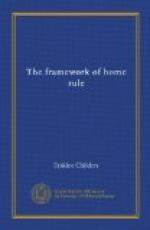I need only briefly summarize the incidents which ended in the year 1782 with the final loss of the American Colonies, and the simultaneous achievement by Ireland of an apparent legislative independence. To take America first, the Stamp Act was passed in 1765, and, thanks to the tumult it created, repealed by the Whigs in 1766, though the Declaratory Act which accompanied the repeal neutralized its good results. The new Revenue Duties on glass, paper, painters’ colours, and tea were imposed in 1767, reviving the old irritation, and all but that on tea were removed, after a period of growing friction, in 1770. Another comparative lull was succeeded by fresh disorder when in 1773 the East India Company was permitted to send tea direct to America, and Boston celebrated its historic “tea-party.” The coercion of Massachusetts followed, with Gage as despotic Military Governor, and, as a result, all the Colonies were galvanized into unity. In September, 1774, the Continental Congress met, framed a Declaration of Rights, and obtained a general agreement to cease from all commerce with Britain until grievances were redressed. Fresh coercion having been applied, war broke out in 1775. The Declaration of Independence was signed on July 4, 1776, by John Hancock, President of Congress and the descendant of an Ulster exile, and was first read aloud in Philadelphia by Captain John Nixon, the son of an evicted Wexford farmer. Another Irishman, General Montgomery, led the invasion of Canada.[14] The war, with manifold vicissitudes, dragged on for eight years; but the surrender of Cornwallis at Yorktown on October 19, 1781, virtually ended the physical struggle, while the resolution of the House of Commons on February 27, 1782, against the further prosecution of hostilities, ended the contest of principle.
The turning-point had been the intervention of the French in 1778, and the same event was to turn the scale in Ireland. There, for many years past, the public finances had been sinking into a more and more scandalous condition. Taxation was by no means heavy, but pensions and sinecures multiplied, and the debt swelled. Inevitably there grew up within Parliament a small independent opposition which would not be bribed into conniving at the ruin of Ireland, while even bought placemen were stung into throwing their votes into the Irish rather than the English scale. Frequent efforts were made to use the insufficiency of the hereditary revenue as a lever




